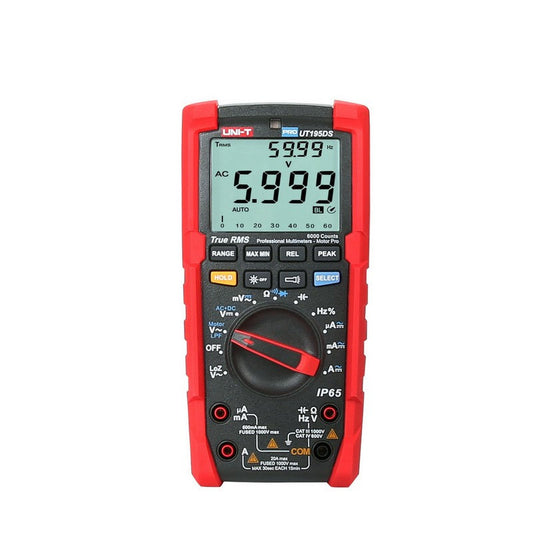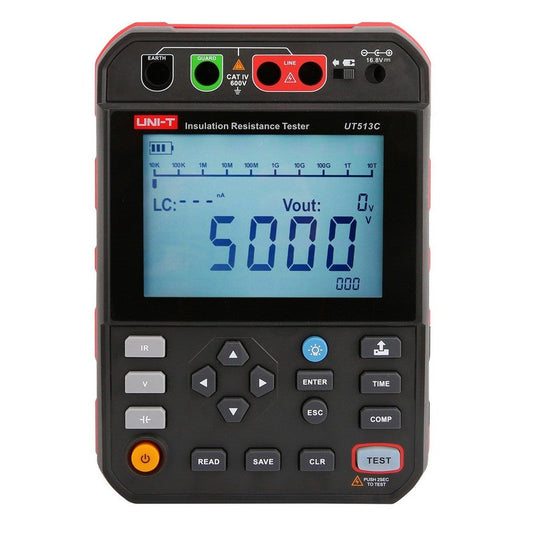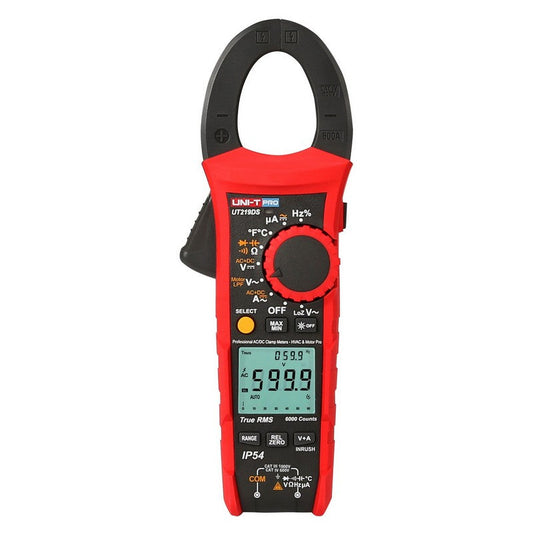UNI-T UT622E Handheld LCR Meter | Advanced Component Analysis Solution
Overview
The UNI-T UT622E handheld LCR meter represents the pinnacle of portable component testing technology, delivering comprehensive measurement capabilities for demanding electronics professionals. As the flagship model in the UT622 series, this advanced instrument combines exceptional 0.1% accuracy with an extended frequency range up to 100kHz and dedicated DC resistance measurement. The high-speed measurement capability of up to 20 times per second accelerates testing workflows, while the crisp 2.8-inch TFT LCD display with high-brightness white backlight ensures perfect visibility in any working environment. Powered by a long-lasting 1800mAh lithium polymer battery supporting 8 hours of continuous operation, the UT622E provides uncompromising measurement performance for laboratory precision in field-ready form factor.
Key Features
-
Extended Frequency Range - Five test frequencies from 100Hz to 100kHz for comprehensive component characterization
-
Professional Measurement Accuracy - Up to 0.1% measurement precision for laboratory-grade results
-
Dedicated DCR Testing - Built-in DC resistance measurement capability with independent test speed settings
-
High-Speed Acquisition - Maximum test speed of 20 times/second for rapid component evaluation
-
Complete Parameter Analysis - Primary parameters (L/C/R/Z/DCR) and secondary parameters (D/Q/θ/ESR)
-
Professional Kelvin Test Leads - Included four-terminal test leads for enhanced measurement accuracy
-
Multiple Test Signal Levels - Three selectable levels (0.1Vrms, 0.3Vrms, 1Vrms) for diverse component types
-
Consistent 100Ω Output Impedance - Ensures measurement stability across all test frequencies
-
Auto LCR Function - Automatically identifies component type for streamlined testing workflow
-
Tolerance Sorting - Adjustable 1%-20% tolerance range with LED pass/fail indication
-
Equivalent Circuit Selection - Series/Parallel mode options for comprehensive component modeling
-
Open/Short Circuit Correction - Clearing correction capability for maximum measurement accuracy
-
USB Connectivity - Standard Mini-USB interface with SCPI command set support
-
Ergonomic Portable Design - Compact 93mm × 192mm × 44mm dimensions weighing only 420g
UNI-T UT622E Details
Advanced Multi-Parameter Measurement
The UNI-T UT622E excels in comprehensive component characterization with its extended parameter measurement capabilities. Beyond the standard inductance (L), capacitance (C), and resistance (R) measurements, the UT622E adds dedicated DC resistance (DCR) testing for complete component analysis. This capability is particularly valuable for inductor characterization, allowing separate measurement of winding resistance independent from AC impedance. The instrument provides both primary parameters (L/C/R/Z/DCR) and secondary parameters (D/Q/θ/ESR), enabling thorough evaluation of component quality and behavior. With measurement ranges spanning from 0.01μH to 99.999H for inductance, 0.00pF to 99.999mF for capacitance, and 0.01mΩ to 20.000MΩ for DC resistance, the UT622E handles virtually any passive component testing requirement with exceptional precision.
Professional-Grade Frequency Range
With five selectable test frequencies (100Hz, 120Hz, 1kHz, 10kHz, and 100kHz), the UT622E provides the most comprehensive frequency coverage in the UT622 series. The extended 100kHz capability enables accurate characterization of high-frequency components and materials, crucial for RF circuit design and telecommunications applications. Different components exhibit varying characteristics across frequency ranges—electrolytic capacitors typically tested at 120Hz, general components at 1kHz, and high-frequency components at 10kHz and above. This versatility makes the UT622E suitable for diverse applications from power supply filtering to RF circuit design. Combined with three selectable test signal levels (0.1Vrms, 0.3Vrms, and 1Vrms), the instrument delivers accurate measurements under conditions closely matching actual operating parameters.
High-Speed Testing Capability
The UT622E features exceptional measurement speed with up to 20 tests per second in fast mode, ideal for production environments and batch testing applications. This rapid acquisition capability reduces testing time while maintaining measurement accuracy, improving throughput in quality control and component sorting operations. Users can select from three speed settings (fast, medium, slow) for both AC and DCR measurements, balancing speed and precision according to application requirements. The fast mode excels in production screening where throughput is critical, medium mode provides balanced performance, and slow mode maximizes accuracy for precision measurements and research applications. This flexibility makes the UT622E equally suitable for high-volume testing and detailed component analysis.
Enhanced Measurement Accuracy
The UT622E delivers exceptional measurement accuracy through multiple technical refinements. The professional four-terminal Kelvin test leads (UTR-L100k-H) included with the instrument minimize lead resistance effects, particularly important for low-impedance measurements. The open/short clearing correction function compensates for parasitic impedances in test fixtures and leads, establishing a precise zero reference for subsequent measurements. The constant 100Ω output impedance ensures consistent test signal application across varying component values and frequencies. Together with the instrument's inherent 0.1% measurement accuracy and high resolution (minimum 0.0001 display resolution), these features provide laboratory-grade measurement precision in a portable form factor, eliminating the compromise typically required between accuracy and portability.
Professional Applications
Electronics Research and Development
In R&D environments, the UNI-T UT622E serves as an essential tool for component characterization and materials analysis. Design engineers can thoroughly evaluate component behavior across multiple frequencies from 100Hz to 100kHz, gaining insights into frequency-dependent characteristics critical for circuit optimization. The dedicated DCR measurement capability allows precise characterization of inductor DC resistance separate from AC impedance, essential for power electronics design and efficiency calculations. The instrument's high precision and comprehensive parameter measurement enable detailed component evaluation during design phases, helping engineers select optimal components and verify their performance under various operating conditions. The USB connectivity with SCPI command set facilitates integration with automated test systems for complex characterization procedures and documentation.
Manufacturing Quality Assurance
The UT622E excels in production testing environments, where its high-speed measurement capability and comprehensive parameter analysis enhance quality control processes. Quality engineers can rapidly verify incoming components against specifications using the tolerance sorting function with clear pass/fail LED indication. The ability to test at multiple frequencies ensures components meet requirements across their intended operating range, not just at a single test point. For inductor manufacturing, the dedicated DCR measurement provides critical information about winding quality and consistency. The instrument's portability allows testing at multiple points in the production process, from incoming inspection to final quality verification, while the high measurement speed of up to 20 times per second maximizes testing throughput without sacrificing accuracy.
Field Service and Equipment Maintenance
Field service technicians benefit from the UT622E's combination of comprehensive measurement capabilities and portable design. When troubleshooting complex electronic systems, the ability to thoroughly characterize components across multiple parameters and frequencies helps identify subtle degradation and failure modes that might be missed by simpler testing tools. The dedicated DC resistance measurement is particularly valuable for evaluating motor windings, transformers, and other inductive components common in industrial equipment. The instrument's extended battery life supports full-day operation without recharging, essential for remote site work. The bright display with white backlight ensures visibility in poorly lit maintenance environments, while the rugged construction withstands the demands of field service work.
Technical Specifications
| Parameter |
Specification |
| Accuracy |
Up to 0.1% |
| Test Frequency |
100Hz, 120Hz, 1kHz, 10kHz, 100kHz |
| Test Level |
0.1Vrms, 0.3Vrms, 1Vrms |
| Output Impedance |
100Ω |
| Primary Parameters |
L/C/R/Z/DCR |
| Secondary Parameters |
D/Q/θ/ESR |
| Auto LCR |
Yes |
| Test Ports |
Three-terminal test jacks, five-terminal test sockets |
| AC Parameters Test Speed |
Fast (20 times/s), medium (5 times/s), or slow (2 times/s) |
| DCR Test Speed |
Fast (20 times/s), medium (5 times/s), or slow (2 times/s) |
| Range Mode |
Auto/Hold |
| Tolerance Range |
1%~20% |
| Equivalent Mode |
Series/Parallel |
| Clearing Correction |
Open/Short circuit |
| Communication Interface |
Mini-USB with SCPI command set |
| LED Alarm |
Pass: green; fail: red |
| Maximum Primary Parameters Reading |
99999 |
| Minimum Resolution |
0.0001 |
| Maximum Accuracy |
0.10% |
| L Range |
0.01μH~99.999H |
| C Range |
0.00pF~99.999mF |
| Z/R Range |
0.0000Ω~9.9999MΩ |
| DCR Range |
0.01mΩ~20.000MΩ |
| ESR Range |
0.0000Ω~999.99Ω |
| D Range |
0.0000~9.9999 |
| Q Range |
0.0000~99999 |
| θ Range |
-179.9°~179.9° |
| Temperature Coefficient |
0.1× (specified accuracy)/°C (0°C18°C or 28°C40°C) |
| Power |
3.7V 1800mAh lithium polymer battery |
| Charging |
Mini-USB: 5V, 1A |
| Display |
2.8" TFT LCD 320×240 |
| Battery Life |
Approximately 8 hours |
| Product Weight |
420g |
| Product Size |
93mm × 192mm × 44mm |
Optional Accessories
| Model |
Description |
Compatibility |
| UTR-001 |
Short Circuit Board |
All UT622 Series |
| UTR-002 |
Alligator Clip Test Leads with Rubber Plugs |
All UT622 Series |
| UTR-L100k-H |
Four-terminal Kelvin Test Leads (included) |
All UT622 Series |
| UT-SC |
Soft Carrying Case |
All UT622 Series |
| UT-SMD |
SMD Component Test Fixture |
All UT622 Series |
| UT-TL |
Tweezers Test Leads for SMD Components |
All UT622 Series |
Package Contents
- UNI-T UT622E Handheld LCR Meter
- Four-terminal Kelvin test leads (UTR-L100k-H)
- Short circuit board (UTR-001)
- USB cable
- 5V/1A power adapter
- English manual
- Gift box packaging
UNI-T UT622 Series Comparison Table
| Parameter |
UT622A |
UT622C |
UT622E |
| Accuracy |
Up to 0.1% |
Up to 0.1% |
Up to 0.1% |
| Test Frequency |
100Hz, 120Hz, 1kHz, 10kHz |
100Hz, 120Hz, 1kHz, 10kHz, 100kHz |
100Hz, 120Hz, 1kHz, 10kHz, 100kHz |
| Test Level |
0.1Vrms, 0.3Vrms, 1Vrms |
0.1Vrms, 0.3Vrms, 1Vrms |
0.1Vrms, 0.3Vrms, 1Vrms |
| Primary Parameters |
L/C/R/Z |
L/C/R/Z |
L/C/R/Z/DCR |
| Secondary Parameters |
D/Q/θ/ESR |
D/Q/θ/ESR |
D/Q/θ/ESR |
| DCR Measurement |
No |
No |
Yes |
| Auto LCR |
Yes |
Yes |
Yes |
| Clearing Correction |
Open/Short circuit |
Open/Short circuit |
Open/Short circuit |
| Max Display |
99999 |
99999 |
99999 |
| Resolution |
0.0001 |
0.0001 |
0.0001 |
| L Range |
0.01μH~99.999H |
0.01μH~99.999H |
0.01μH~99.999H |
| C Range |
0.00pF~99.999mF |
0.00pF~99.999mF |
0.00pF~99.999mF |
| Z/R Range |
0.0000Ω~9.9999MΩ |
0.0000Ω~9.9999MΩ |
0.0000Ω~9.9999MΩ |
| ESR Range |
0.0000Ω~999.99Ω |
0.0000Ω~999.99Ω |
0.0000Ω~999.99Ω |
| Display |
2.8\" TFT LCD (320×240) |
2.8\" TFT LCD (320×240) |
2.8\" TFT LCD (320×240) |
| Battery |
3.7V 1800mAh Li-Poly |
3.7V 1800mAh Li-Poly |
3.7V 1800mAh Li-Poly |
| Charging |
Mini-USB 5V 1A |
Mini-USB 5V 1A |
Mini-USB 5V 1A |
| Weight |
420g |
420g |
420g |
| Size |
93mm × 192mm × 44mm |
93mm × 192mm × 44mm |
93mm × 192mm × 44mm |
Frequently Asked Questions
What makes the 100kHz test frequency capability valuable in component testing?
The 100kHz test frequency significantly extends the UT622E's component analysis capabilities, particularly for high-frequency applications and advanced material characterization. At higher frequencies, component behavior often changes dramatically from low-frequency characteristics – parasitic effects become more pronounced, and core materials in inductors behave differently. This extended frequency range allows engineers to evaluate components under conditions closer to their actual operating environment in RF circuits, switch-mode power supplies, and high-speed digital systems. For materials research, the 100kHz capability enables characterization of dielectric and magnetic materials across broader frequency spectrums. Without this high-frequency testing ability, components that appear identical at lower frequencies might show significant performance differences in actual high-frequency applications.
How does the dedicated DCR measurement function benefit inductor testing?
The dedicated DC resistance (DCR) measurement function provides critical insights into inductor quality and performance that cannot be obtained from AC measurements alone. DCR directly measures the copper resistance of inductor windings, which is essential for power loss calculations in power electronics applications. Unlike the standard AC resistance measurement, which includes core losses and other frequency-dependent effects, the DCR value isolates the winding resistance component. This separation allows engineers to accurately predict thermal behavior and efficiency in power applications. The UT622E's wide DCR measurement range (0.01mΩ to 20.000MΩ) with independent test speed settings ensures accurate measurement of both ultra-low resistance power inductors and high-resistance RF chokes, making it invaluable for comprehensive inductor characterization.
Can the UT622E's high test speed benefit production testing environments?
Absolutely. The UT622E's maximum test speed of 20 measurements per second significantly enhances productivity in manufacturing and quality control environments. This rapid measurement capability directly translates to higher throughput in component sorting, incoming inspection, and production line testing. For example, in a component sorting application, the high-speed mode combined with the tolerance sorting function and LED indication allows operators to test hundreds of components per hour with clear pass/fail feedback. Production managers appreciate the flexibility to choose between three speed settings, balancing throughput and precision based on specific quality requirements. For high-volume manufacturers, this speed advantage can yield substantial time and cost savings compared to standard-speed instruments, while maintaining the measurement accuracy necessary for quality assurance.
How does the four-terminal Kelvin test connection improve measurement accuracy?
The four-terminal Kelvin test connection included with the UT622E eliminates a major source of measurement error in component testing by separating current-carrying and voltage-sensing paths. In conventional two-terminal measurements, the same leads carry test current and sense voltage, causing lead resistance to be included in the measurement – a significant problem for low-impedance components. The Kelvin method uses separate pairs of leads: one pair carries the test current while the other pair senses the voltage directly at the component terminals, effectively eliminating lead resistance from the measurement. This approach dramatically improves accuracy for low-impedance measurements such as low-value resistors, small inductors, and large capacitors. The professional UTR-L100k-H Kelvin test leads included with the UT622E ensure this accuracy advantage is maintained even in field testing applications.
How can the UT622E be integrated into automated test systems?
The UT622E offers straightforward integration with automated test systems through its Mini-USB interface and industry-standard SCPI command set support. This standardized command structure allows test engineers to control the instrument from various test automation platforms without requiring specialized drivers. In automated environments, the instrument can be programmed to perform specific measurement sequences, with results collected and analyzed by the control system. This capability is particularly valuable for documented quality procedures requiring consistent test methods and result archiving. The instrument's high measurement speed further enhances its suitability for automated testing, minimizing test cycle times. While not offering the throughput of dedicated automated component testers, the UT622E provides an economical solution for small to medium production operations requiring documented test procedures and results traceability.
What is the advantage of having both series and parallel equivalent modes?
The series and parallel equivalent modes in the UT622E provide essential flexibility for accurately modeling real-world component behavior in different circuit contexts. Real components don't behave as ideal elements but include parasitic resistances that can be represented either as series or parallel elements. The appropriate model depends on the component type and application context – for example, electrolytic capacitors are typically represented in series mode to account for ESR (Equivalent Series Resistance), while ceramic capacitors are often better represented in parallel mode. By offering both modeling approaches, the UT622E enables engineers to obtain measurements that accurately reflect component behavior in specific circuit configurations. This capability is particularly valuable in design verification, where understanding component behavior in its intended circuit context is critical for predicting overall circuit performance and reliability.
Customer Testimonials
"As an R&D engineer developing power electronics for automotive applications, the UT622E has become indispensable in my component evaluation workflow. The dedicated DCR measurement capability is particularly valuable for characterizing power inductors, allowing me to precisely evaluate both AC and DC characteristics. The 100kHz test frequency has proven essential for evaluating components under conditions closer to their actual operating parameters." - Rajiv M., Power Electronics Developer
"Our electronics manufacturing facility uses the UT622E for both incoming inspection and production quality verification. The high-speed measurement capability significantly increases our testing throughput, while the comprehensive parameter analysis ensures we catch subtle component issues before they affect our finished products. The tolerance sorting function with LED indication has dramatically improved our component screening efficiency." - Nadia K., Quality Control Supervisor
"In my field service role maintaining industrial automation systems, the UT622E's combination of portability and comprehensive measurement capabilities has proven invaluable. The ability to perform detailed component characterization on-site often allows me to diagnose complex issues without returning equipment to the shop. The extended battery life easily supports full-day operation in remote locations, and the rugged construction has withstood harsh industrial environments." - Thomas L., Field Service Engineer
Warranty and Support
The UNI-T UT622E handheld LCR meter is backed by a comprehensive 1-year warranty covering manufacturing defects and component failures under normal use conditions. UNI-T provides dedicated technical support through our experienced engineering team, with responsive service available via phone, email, and our online knowledge base. Calibration services and extended warranty options are available to ensure your instrument maintains peak performance throughout its service life.
The Ultimate Portable Component Analyzer
The UNI-T UT622E handheld LCR meter delivers uncompromising measurement performance for professionals requiring comprehensive component characterization in a portable package. With its extended frequency range, dedicated DC resistance measurement, and professional four-terminal test leads, the UT622E brings laboratory-grade analysis capabilities to field and production environments. Experience the difference that complete component characterization makes in your electronics development, manufacturing, and maintenance applications.















